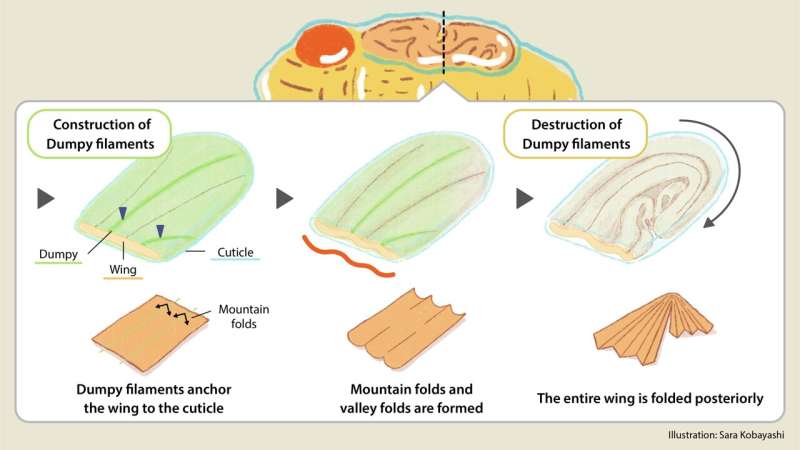This article has been reviewed according to Science X's editorial process and policies. Editors have highlighted the following attributes while ensuring the content's credibility:
fact-checked
peer-reviewed publication
trusted source
proofread
Unveiling the mechanism of 3D folding in cell sheets

The artist in nature creates wonders of geometric patterns, as can be seen in the wings of Drosophila fruit flies just after emerging from their pupal case, which is known as eclosion. They meticulously fold into stereotypic shapes, just like in the paper-folding art of origami, invented from humanity's innate sense of spatial awareness.
Yet, no human intervention is required when the wings fold themselves with uncanny precision according to nature's complex blueprint.
Now, a team of researchers at Kyoto University has revealed that the Dumpy protein, a component of extracellular matrices—or ECM—is the key factor in regulating the stereotypic origami-like folding of wing-cell sheets.
"Our findings are unique because they unveil how external cues can create consistent 3D tissue structures," says first author Alice Tsuboi of KyotoU's Graduate School of Biostudies.
According to conventional views of morphogenesis, coordinated cell behaviors, like cell division and cell shape changes, are responsible for shaping cell sheets and creating folds, such as mountain-valley patterns. Researchers may naturally assume that wing folding is controlled by these cell behaviors.
"It turns out, however, that wing cells never divide during folding nor do they exhibit spatially distinct behaviors," adds Tsuboi.
These unexpected findings led Tsuboi's team to investigate whether external factors might control the folding pattern. Using genetics and protein visualization techniques, the team found that Dumpy, a fibrous ECM protein, mediates the adhesion of cell sheets to their surroundings.
Additionally, the spatial and temporal regulation of Dumpy deposition and destruction ensures the stereotypic folding of the wing.
"During a casual walk, I stumbled upon the eclosion of a cicada, which triggered my interest in the morphogenic mechanisms involved," says Tsuboi, who saw an opportunity to examine whether an ECM-based mechanism may be a means to manufacturing diverse and controllable 3D tissue folding with coordinated cell behaviors.
"We believe that the next step is in examining how tissues encode positional information in ECM remodeling, which may provide new insight into organ development and regeneration," adds Tsuboi.
The paper "Spatiotemporal remodeling of extracellular matrix orients epithelial sheet folding" appeared in Science Advances.
More information: Alice Tsuboi et al, Spatiotemporal remodeling of extracellular matrix orients epithelial sheet folding, Science Advances (2023). DOI: 10.1126/sciadv.adh2154
Journal information: Science Advances
Provided by Kyoto University




















